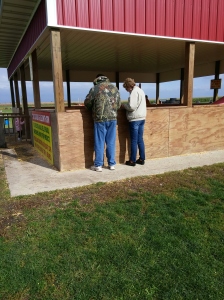For an entire year, I’ve been anticipating our family’s return to Stade’s Shades of Autumn Festival. My excitement has been building for one reason: To estimate the amount of corn contained in their corn play area (or the Corn Sandbox as my 4 year-old has named it).
We went last Friday, armed with a measuring tape and a measuring cup. The sign seemed to give away the answer of 800 bushels, but I wasn’t satisfied given that their was no mathematics to back up their claim. We needed to attend to precision. Here are some of the photos I took:
My favorite is the bottom photo, my parents counting kernels of corn in 1 cup. (There are 579, by the way)
I love when I present a problem to my class, and it takes longer than I anticipate for them to solve. There was supposed to be time for solving inequalities for the group that worked with this, but that will just have to wait until tomorrow. I’m sure they were crushed.
The essential question we wanted to answer was: How many kernels of corn are there in this corn sandbox?
Initial estimates were very low. I let them revise after I revealed that 1 cup contained 579 kernels.
One approach: Use the number of bushels to calculate kernels.
After looking up on Wolfram Alpha that 1 bushel = 9.31 gal, we determined that a reasonable calculation of the number of kernels, based on our 1 cup count, was 69,000,000.
Second Approach: Use the volume of the enclosure to calculate kernels.
This was a little trickier given the irregular shape of the sandbox. Numerous calculations and conversions later, we arrived at 81,667,931 kernels of corn.
We were uncomfortable with the over 12 million kernel discrepancy between our two methods. It remains unclear which is more accurate given the fact that one includes actual measurements and assumptions and the other is provided by the farm. Perhaps Stade’s Farm should expect a call from Mrs. Schmidt’s 2nd hour Algebra 2 class in the near future to clear this up.





Good one, glad I got my picture in it.
We looked up how much 1 cubic foot weighed and estimated the dimensions of the “cornbox.” One student was within 200 lbs of the actual weight given – an error percentage of 0.4%. Did not delve into the number of kernels 🙂 But VERY satisfied by our estimations!
That’s awesome! Tell me more about this tomorrow!